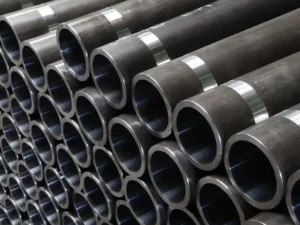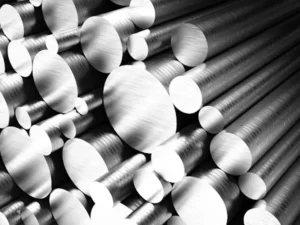The debate between Mild Steel vs. Carbon Steel has long intrigued engineers and manufacturers. The reason is that carbon steel accounts for 85% of all the steel produced and is extensively used worldwide in different industries.
It is further divided into different types and grades – mild steel is one of those types. However, this guide will compare mild and carbon steel side by side and give you insight into their differences. So, let’s jump into it!
Introduction to Mild and Carbon Steel
Mild steel is a type of carbon steel that differs in carbon content. Carbon steel is more robust and has a higher carbon content (0.30 to 2%). Conversely, mild steel has a meager carbon amount (0.05 to 0.25%) and is soft.
Although they both are types of steel, their usability and functionality vary because of the difference in carbon content. Carbon steel is suitable for construction, and mild steel is used to make daily routine products such as plates, pipes, tubes, etc.
Among all the types of carbon steel, mild steel is the most famous and widely used. Thanks to its features such as softness, ease of welding, and transformation into different shapes. Many industries prefer mild steel over all other types unless they aim to make something solid.
Mild Steel vs. Carbon Steel: Basic Differences
Apart from the cost-effectiveness of mild steel, many other differences make both suitable for different industries. Before we discuss their differences in detail, here is a quick table giving you a first glance at these two types.
| Characteristic | Carbon Steel | Mild Steel |
| Carbon Content | Higher (0.30 to 2%) | Lower (0.05 to 0.25%) |
| Cost Effectiveness | Relatively Higher | Affordable and Cheaper |
| Production | More Complex, Expensive | Easy to Produce, Less Expensive |
| Strength and Hardness | Stronger and harder | Weaker and Softer |
| Welding | Less Weldable due to brittleness | Weldable and make a strong weld |
| Resistance to Corrosion | Not Resistant | Not Resistant |
| Machinability | Lower Machinability | Higher Machinability |
| Malleability/Ductility | Less Malleable, Less Ductile | More Malleable, More Ductile |
| Applications | Higher Strength Applications | Flexibility and Formability Applications |
After reading the table, you got some fundamental differences between these two types. Let’s dive deeper and discuss their disparities in a detailed explanation.
1- Composition

The composition is a primary and differentiating factor. Both carbon steel and mild steel are alloys of carbon and iron. However, the carbon content varies in both types, making them bulls apart.
The carbon steel has more carbon content ranging from 0.30 to 2%. Conversely, mild steel has a lower carbon content of 0.05 to 0.25%. Due to its high carbon proportion, carbon steel is more robust and more rigid. That’s why it is used in construction and other industries where durability and strength are priorities.
Remember that many other elements are also alloys in both these types. For example, mild steel can contain manganese, silicon, and phosphorus. However, carbon and iron dominate in both carbon steel and mild steel.
2- Production/Formation
The mild steel is relatively more straightforward to produce as it requires less energy. Its production involves smelting iron ore in blast furnaces to produce pig iron. Once the pig iron is made, it undergoes the electric arc, removing all the impurities, and mild steel comes out as a product.
The production of carbon follows the same steps. However, it requires more energy. Additional heat treatment is needed to adopt properties such as hardness and strength. These extra steps make the process more complex and costly.
There are different steps and processes involved in their production. However, we won’t go into the details as we aim to understand their production ease and effectiveness from the manufacturers’ point of view. So, the mild steel is cost-effective and easy to produce.
3- Types & Categories
Carbon steel is divided into different types, and one of them is mild steel. These types of carbon steel vary based on carbon content. Notably, the mild steel has no particular types and is a subdivision. Here is the list of the kinds of carbon steel:
- Low Carbon Steel: It is also known as mild steel and has a shallow carbon content. It is soft, and many industries use it extensively.
- Medium Carbon Steel: It is more robust than mild steel; however, its usability is less extensive than mild steel. Its carbon content is 0.3 to 0.6%, making it decently strong. Notably, this type of carbon steel is brittle and cannot be readily welded by welding.
- High Carbon Steel: It is brittle and breaks on heating instead of welding. Moreover, it has a carbon content of 0.6% to 1.5%, making it suitable for construction-related industries. However, its usage is only at larger scales, i.e., in making skyscrapers or constructions.
4- Strength, Hardness & Usability

The strength and hardness of the steel are due to its carbon content. More carbon means that the steel will be strong and vice versa. The mild carbon has the lowest carbon content, indicating it is softer and weaker.
On the other hand, carbon steel has increased carbon content and is more robust and more rigid. However, its high carbon content makes it less usable. The reason is that more carbon increases its brittleness and cannot be welded.
Mild steel has a low carbon content, which makes it significantly less brittle. It can be easily welded and supports the welding process. Many industries use mild steel to create products that can be welded repeatedly, such as plates, pipes, tubes, etc.
5- Malleable and Ductility
Mild steel has low carbon content and a greater tensile strength (maximum stress material can bear before breaking). It can be transformed into any shape, such as wires or sheets. Moreover, the mild steel is not brittle, indicating it won’t break easily.
So, mild steel can be drawn into sheets, wires, and other products due to its excellent tensile strength and flexibility. On the other hand, carbon steel is tough. It is not malleable and ductile. It cannot be used to make sheets or wires.
6- Surface Finish

Carbon steel is tough and contains a high carbon content. Due to its increased carbon content, it is rough on the surface and does not look aesthetically pleasing. Higher carbon content supports the scale formation during the heating process of carbon steel.
On the other hand, mild steel is soft and offers a better surface finish. Its edges look sharp and aesthetically pleasing. Their better surface helps when you apply the paint to protect it from corrosion and other external factors.
7- Response to Heat Treatment/Weldability
Carbon steel is more robust, so it will bear the heat and get even more robust when exposed to heat. On the opposite side, the mild steel is weak, does not bear the heat, and starts to melt when the heat is applied.
When the temperature is applied to mild steel, it starts to melt, which is its strength. Due to its melting on heating, it can be welded. This property allows for seamless welding, making it a preferred choice across various industries.
8- Sensitivity to Corrosion
Both carbon and mild steel consist of iron, which reacts with oxygen and iron oxide (rust). Unfortunately, neither offers significant resistance to rust, corrosion, and other external elements.
However, they can be protected by applying a thick coat of paint. The layer of paint protects the steel and helps it maintain its shape and strength for an extended period. However, this is not the perfect long-term solution as well.
9- Cost & Pricing
The mild steel is inexpensive as compared to carbon steel. Due to the cost-effectiveness of mild steel, it is widely used across all industries where flexibility and weldability are required. Its performance, softness, and ability to transform into different shapes make it stand out.
Although carbon steel is expensive, it is still prevalent in construction, automobiles, and other industries where the strength and hardness of the steel are required. Ultimately, both types have their uses depending on their features.
Verdict: Which one is Better, Mild or Carbon Steel?
Saying one is the better option than the other is not viable. The reason is that these two steel types are suitable for different purposes. For example, mild steel is the perfect solution for making smaller, weldable products like pipes, motors, chairs, shelves, tools, wirings, etc.
Similarly, carbon steel is suitable for different industries where the strong material is supposed to be made. For example, the construction industry uses carbon steel due to its strength and hardness. Both of these types serve in their ways. Their usability depends on the purposes of manufacturers.
Why is Mild Steel Prefered in Fabrication Processes?
Fabrication is all about cutting and molding the material into shapes. Mild steel is prioritized because it is easily transformable into any shape. Even manufacturers can use it to make complex, impossible shapes.
The mild steel is cost-effective and easily affordable for fabricators. Above all, mild steel makes a strong weld. The mild steel melts when the heat is applied, making a very durable weld. Due to all these features, mild steel is preferred for the fabrication process over carbon steel.
Remember that the counterpart (carbon steel) is solid and hard. It cannot be used to make any structure or shape. When welding, carbon steel breaks due to its brittleness. That’s the reason why it is considered an ordinary option when it comes to fabrication.
Does Carbon Steel Rust Easily?
Unfortunately, carbon steel quickly gets rusty when it comes into contact with moisture. The reason is that iron is very reactive and immediately reacts with oxygen to form iron oxide, which is rust.
It is not just carbon steel; mild steel is also susceptible to rust and corrosion. However, the manufacturers apply a layer of paint to protect the steel from rust. The coat protects the material from the rust.
However, it is a short-term solution, and the challenge of rust will only be around for a while. If you aim to manufacture something rust-resistant, you should use stainless steel. The reason is that it offers excellent resistance to rust.
How Strong is Carbon Steel vs. Mild Steel?
It is impossible to tell how much more robust carbon steel is compared to mild steel. As I said earlier, carbon steel’s strength depends on the carbon content or proportion. More carbon means that the steel has greater strength and vice versa.
Different types of carbon steel have different carbon content. Those carbon steel that have a more significant carbon proportion will be more robust than those types of carbon steel that have a lesser proportion and vice versa. It is all about the amount of carbon content.
Conclusion
Both mild and carbon steel are the heart of different industries. Their usability has led manufacturers to produce various products. They are different from each other and are usable depending on their properties and functionality.
In this comparison article, I’ve mentioned all of their fundamental differences. The mild steel is soft and suitable for a lower scale. The carbon is strong and used on a large scale, such as in the construction industry. However, mild steel usability is more common than that of its counterpart.
